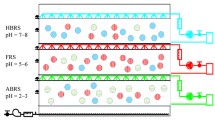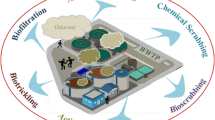Abstract
An economic and technical comparison of two odor control systems, a biofilter and a chemical wet scrubber, was conducted over a 1-year time period at a large municipal wastewater treatment plant. The biofilter system was designed to remove hydrogen sulfide gas and other oxidizable sewage odors from four covered gravity sludge thickeners, a gravity sludge thickener effluent channel and an influent splitter box for the gravity sludge thickeners. The sodium hypochlorite/sodium hydroxide wet scrubber was designed to control hydrogen sulfide gas and other oxidizable sewage odors from the covered primary settling tanks, influent distribution channels and effluent channel, and the mixing tank effluent channel. The technical comparison comprised their overall removal rates and efficiencies based on inlet HZS concentrations and other operating variables. The economic comparison was designed to provide the cost per cubic meter of H2S removed for each system.
Influent and effluent gas samples were collected on a weekly basis. H2S concentration levels were determined through the use of gas chromatography with a flame photometric detector. The results showed that the H2S inlet gas concentration has a seasonal change with a maximum value occurring in August and September. The effluent H2S concentration was lower than 2 ppmv for both systems for most of the samples. The efficiency for both the biofilter and wet scrubber was above 95%, and was related to the operating and ambient conditions.
The economic comparison revealed that the actual unit cost for the biofilter was higher than for the wet scrubber (U.S.$160/m3 H2S removed versus U.S.$131/m3 H2S removed). For both the biofilter and the wet scrubber, the investment costs are affected by the size/scale of the system, the design flow and other factors. For these systems, the mulch change costs, chemical usage costs, maintenance costs and power usage costs were mainly dependent on the actual odor gas loadings which showed substantial seasonal fluctuations as a function of the seasonal temperature. The worst case conditions reported here indicate that the H2S concentrations generated during the summer months should be used to determine the design load.
Similar content being viewed by others
References
Yonghua Y, Allen ER (1994) Biofiltration control of hydrogen sulfide. 2. Kinetics, biofilter performance, and maintenance, J. Air Waste Manage. Assoc. 44:1315–1321
Gao L (2000) A technical and economic comparison of biofilters and wet chemical scrubbers for odor control at wastewater treatment plants, Master’s Thesis, The University of Cincinnati, August
Blank LT, Tarquin AJ (1998) Engineering Economics, 4th edn. WCB/McGraw-Hill, New York
Consumer Price Indexes, http://stats.bls.gov/cpihome.htm
United States Historical Inflation Rates, www.globalfindata.com
Author information
Authors and Affiliations
Corresponding author
Additional information
This work has been supported in part by the Metropolitan Sewer District of Greater Cincinnati under contract number 85X8274.
Rights and permissions
About this article
Cite this article
Gao, L., Keener, T.C., Zhuang, L. et al. A technical and economic comparison of biofiltration and wet chemical oxidation (scrubbing) for odor control at wastewater treatment plants. Environmental Engineering and Policy 2, 203–212 (2001). https://doi.org/10.1007/s100220100036
Received:
Published:
Issue Date:
DOI: https://doi.org/10.1007/s100220100036




